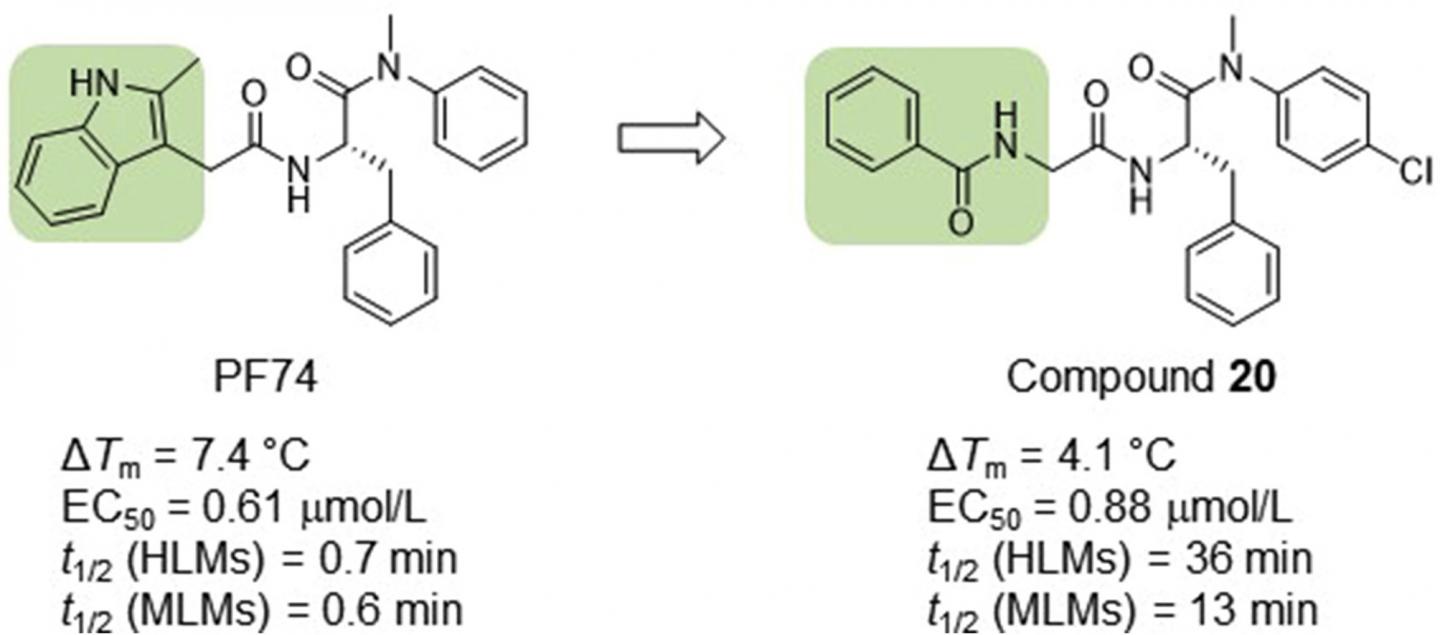Balance of potency and metabolic stability

Credit: Acta Pharmaceutica Sinica B
Novel PF74-like small molecules targeting the HIV-1 capsid protein: Balance of potency and metabolic stability
https:/
Of all known small molecules targeting human immunodeficiency virus (HIV) capsid protein (CA), PF74 represents by far the best characterized chemotype, due to its ability to confer antiviral phenotypes in both early and late phases of viral replication. However, the prohibitively low metabolic stability renders PF74 a poor antiviral lead. The authors report on their medicinal chemistry efforts toward identifying novel and metabolically stable small molecules targeting the PF74 binding site. Specifically, they replaced the inter-domain-interacting, electron-rich indole ring of PF74 with less electron-rich isosteres, including imidazolidine-2,4-dione, pyrimidine-2,4-dione, and benzamide, and identified four potent antiviral compounds (10, 19, 20 and 26) with markedly improved metabolic stability. Compared to PF74, analog 20 exhibited similar submicromolar potency, and much longer (51-fold) half-life in human liver microsomes (HLMs). Molecular docking corroborated that 20 binds to the PF74 binding site, and revealed distinct binding interactions conferred by the benzamide moiety. Collectively, the authors data support compound 20 as a promising antiviral lead.
###
Article reference: Lei Wang, Mary C. Casey, Sanjeev Kumar, V. Vernekar, Rajkumar Lalji Sahani, Karen A. Kirby, Haijuan Du, Huanchun Zhang, Philip R. Tedbury, Jiashu Xie, Stefan G. Sarafianos, Zhengqiang Wang, Novel PF74-like small molecules targeting the HIV-1 capsid protein: Balance of potency and metabolic stability, Acta Pharmaceutica Sinica B, 2021, ISSN 2211-3835, https:/
Keywords: HIV-1, Capsid protein, PF74, Microsomal stability
The Journal of the Institute of Materia Medica, the Chinese Academy of Medical Sciences and the Chinese Pharmaceutical Association.
Acta Pharmaceutica Sinica B (APSB) is a monthly journal, in English, which publishes significant original research articles, rapid communications and high-quality reviews of recent advances in all areas of pharmaceutical sciences — including pharmacology, pharmaceutics, medicinal chemistry, natural products, pharmacognosy, pharmaceutical analysis and pharmacokinetics.
For more information please visit https:/
Editorial Board: https:/
APSB is available on ScienceDirect.
Submissions to APSB may be made using Editorial Manager®.
CiteScore: 10.5
Impact Factor: 7.097
5-Year Impact Factor: 7.865
Source Normalized Impact per Paper (SNIP): 2.210
SCImago Journal Rank (SJR): 1.792
ISSN 2211-3835
Media Contact
Morgan lyons
[email protected]
Related Journal Article
http://dx.





